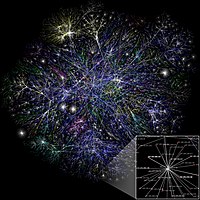
Photo from wikipedia
Deep learning has achieved impressive results on hyperspectral images (HSIs) classification. Among them, both convolutional neural networks (CNNs) and graph neural networks (GNNs) have great potential for hyperspectral image classification.… Click to show full abstract
Deep learning has achieved impressive results on hyperspectral images (HSIs) classification. Among them, both convolutional neural networks (CNNs) and graph neural networks (GNNs) have great potential for hyperspectral image classification. Supervised CNNs can efficiently extract hierarchical spatial-spectral features of hyperspectral images, but these methods face the problem of high time complexity as the number of network layers increases. Semi-supervised GNNs can rapidly capture the structural information of HSIs, while they cannot be well extended to hyperspectral image applications because of the process of adjacency matrix consuming large amount of memory resources. In this paper, we propose a fast dynamic graph convolutional network (dynamic GCN) and CNN parallel network (FDGC) for HSI classification. We first obtain two classification features by flattening and pooling operations on the results of the convolution layers, which fully exploits the spatial-spectral information contained in the hyperspectral data cube. Then a dynamic graph convolution module is applied to extract the intrinsic structural information of each patch. Finally, we can obtain the HSI classification results based on these spatial, spectral and structural features. By using three branches, FDGC can parallel process multiple features of HSI in a supervised learning manner. In addition, regularization techniques such as DropBlock and label smoothing are applied to further improve the generalization capability of the model. Experimental results on three datasets show that our proposed algorithm is comparable with the state-of-the-art supervised learning models in terms of accuracy while also significantly outperforming in terms of training and inference time.
Journal Title: IEEE Transactions on Geoscience and Remote Sensing
Year Published: 2022
Link to full text (if available)
Share on Social Media: Sign Up to like & get
recommendations!